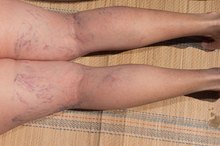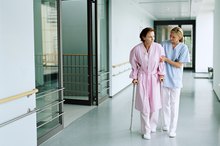What Are the Treatments for Circulation Problems After Surgery?
Patients undergoing surgery are at risk for developing circulatory problems such as hypovolemic shock due to loss of fluids and blood. Patients undergoing major procedures, as well as those in generally poor health, are most at risk for fluid loss. Lengthy procedures and those that require bed rest post-operatively place the patient at risk for developing blood clots in the legs because the blood tends to pool in the lower extremities, according to the Merck Manual. Treatment is tailored to the cause of the circulatory problem.
If you are experiencing serious medical symptoms, seek emergency treatment immediately.
Fluids
Hypovolemic shock may occur during or after surgery because of fluid or blood loss. The decreased volume within the circulatory system cannot provide needed oxygen and nutrients to the tissue, resulting ultimately in death if the problem is not resolved. Intravenous fluids are administered to prevent hypovolemic shock if possible. If the patient goes into hypovolemic shock, treatment usually consists of administering intravenous fluids to replace the lost volume. If the patient has lost blood, the surgeon will order packed red blood cells, platelets and coagulation factors—components of whole blood that assist with clotting, according to Sandra Nettina, R.N., M.S.N., in her book “Lippincott Manual of Nursing Practice. 3”
- Hypovolemic shock may occur during or after surgery because of fluid or blood loss.
- The decreased volume within the circulatory system cannot provide needed oxygen and nutrients to the tissue, resulting ultimately in death if the problem is not resolved.
Compression
Deep Vein Thrombosis & Physical Therapy
Learn More
Compression hose or elastic wraps are used to prevent blood from pooling in the legs and forming blood clots that could break off and travel to the lungs. The consequences of deep vein thrombosis, or DVT, are serious and potentially life-threatening, so prevention is important, particularly when the surgical procedure is lengthy or the patient must be immobile for some time after, according to the Merck Manual. The hose or wraps are applied to the patient’s lower legs from toes to the groin before surgery and are left in place after until he is able to walk and move about. Patients who are at high risk of DVT, including those with preexisting circulatory problems as well as those undergoing abdominal or pelvic procedures, may benefit from external pneumatic compression devices that apply sequential pressure from the ankle to the thigh, impeding blood flow back to the heart, according to Nettina.
- Compression hose or elastic wraps are used to prevent blood from pooling in the legs and forming blood clots that could break off and travel to the lungs.
- The consequences of deep vein thrombosis, or DVT, are serious and potentially life-threatening, so prevention is important, particularly when the surgical procedure is lengthy or the patient must be immobile for some time after, according to the Merck Manual.
Activity
Movement improves circulation in the lower extremities by exercising the muscles that help the blood to flow back to the heart. Patients are encouraged to move their legs in the bed as soon as possible after waking from anesthesia and to walk as soon as the surgeon gives permission. Patients are also instructed to avoid rubbing their legs, standing or sitting for long periods, crossing their legs, placing a pillow under the knees while in bed or using any item that restricts blood flow, according to Nettina.
Anticoagulants
Diuretics and Low Blood Pressure
Learn More
Patients undergoing surgical procedures that are most likely to cause blood clots, as well as those who will need to remain in bed post-operatively, may receive medication such as heparin that prevent the blood from clothing, according to the Merck Manual. Anticoagulants may not be safe, however, if they increase the likelihood of hemorrhage during or after surgery.
Related Articles
References
- Merck Manuals Online Medical Library: Postoperative Care
- “Lippincott Manual of Nursing Practice, 9th ed.;” Sandra M. Nettina, MSN, ANP-BC; 2010
Writer Bio
Marcy Brinkley has been writing professionally since 2007. Her work has appeared in "Chicken Soup for the Soul," "Texas Health Law Reporter" and the "State Bar of Texas Health Law Section Report." Her degrees include a Bachelor of Science in Nursing; a Master of Business Administration; and a Doctor of Jurisprudence.









